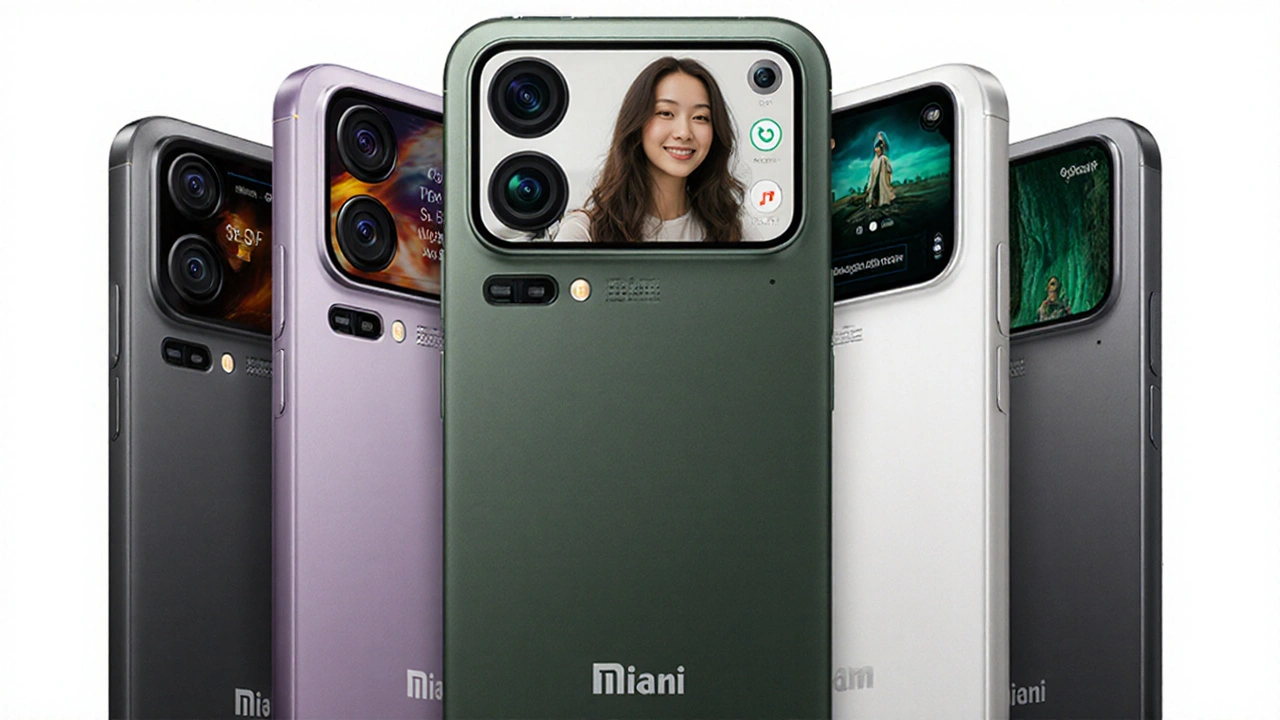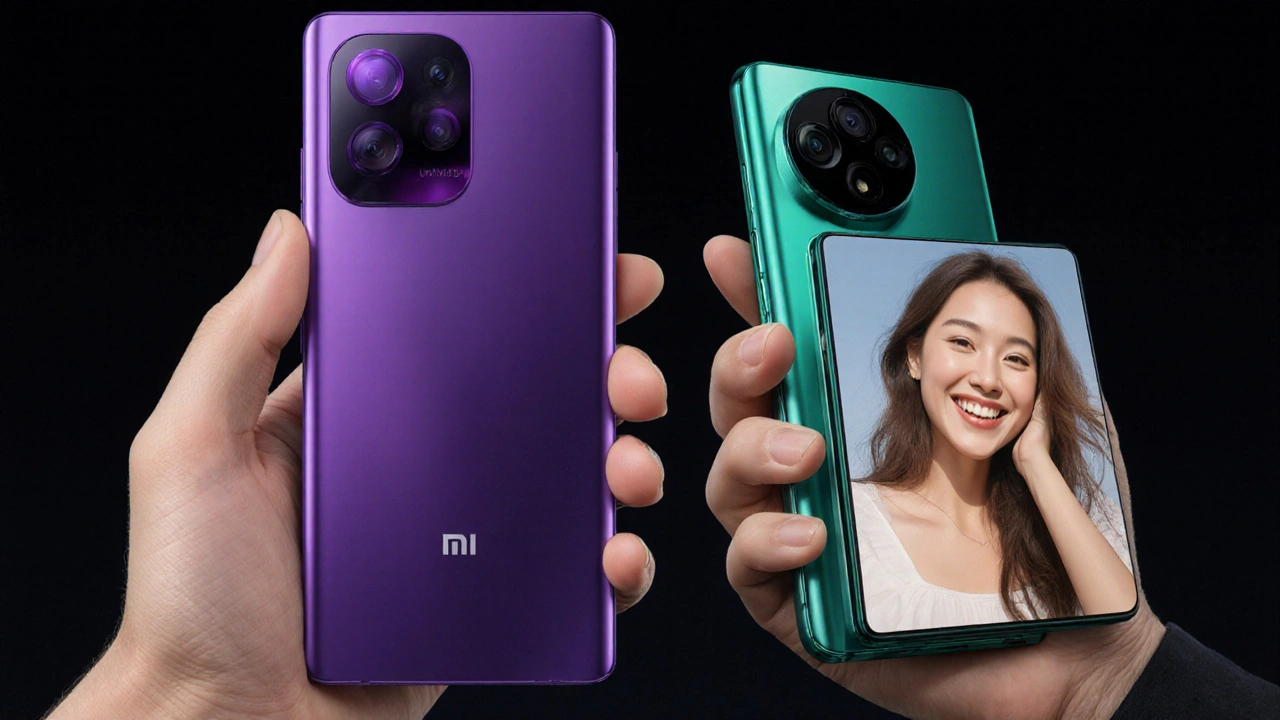What’s Inside the New Xiaomi 17 Line‑up?
The three models share a common DNA: Qualcomm’s brand‑new Snapdragon 8 Elite Gen 5 processor, a ten‑nanometer‑plus architecture that promises up to 30 % more AI performance than the previous generation. Coupled with Xiaomi Hyper OS 3, the software feels snappier, with smoother animations and tighter memory management. Storage choices range from a base 256 GB to a massive 1 TB option exclusive to the 17 Pro Max, while RAM caps at 16 GB for the top tier.
Battery capacity is where the series really tries to shake the market. The standard 17 carries a 5,200 mAh cell, the 17 Pro steps up to 6,300 mAh, and the Pro Max pushes the envelope with a 7,500 mAh pack – the largest ever fitted in a flagship phone as of September 2025. All three support 100 W PPS fast charging, meaning a full charge in under 30 minutes in ideal conditions. Xiaomi also added a 30 W reverse‑wireless charging mode, allowing the phone to act as a power bank for earbuds or another handset.
- Snapdragon 8 Elite Gen 5 – first‑ever implementation in a commercial device
- Hyper OS 3 – redesigned UI with Gesture Nav Plus and AI‑driven battery saver
- Display options – 6.1" LCD on the 17, 6.5" AMOLED on the Pro, 6.9" SuperRED OLED on the Pro Max
- Camera suite – 108 MP main sensor across the line, 12 MP ultra‑wide, 5 MP macro, and 10 MP periscope telephoto on the Pro Max
- Audio – dual‑stage speaker system with Dolby Atmos support

Design, Extras and How Xiaomi Plans to Take on the Flagship Crowd
The 17 Pro Max steals the spotlight with its 6.9‑inch QHD+ SuperRED OLED panel, a 1220 × 2656 resolution that hits 463 ppi. The panel uses a next‑generation M10 backplane, delivering better color accuracy and lower power draw than the older M8 tech. A unique touch is the rear‑facing dynamic secondary display – a thin, customizable touchscreen that can show music controls, notifications or a quick selfie preview without waking the main screen.
Build quality feels premium: a brushed titanium frame houses the shock‑absorbing polymer back, while the front glass is Corning Gorilla Glass Victus 2. The devices are IP68 certified, meaning they survive submersion in up to 1.5 meters of water for 30 minutes. For photographers, the Pro Max adds a 10‑megapixel periscope lens capable of 5× optical zoom and up to 50× digital zoom, backed by sensor‑shift OIS.
From a market perspective, Xiaomi’s product manager Jang Yu says the goal is simple – beat Apple and Samsung on two fronts that matter to power users: battery life and charge speed. The 7,500 mAh cell translates to roughly 45 hours of video playback, while the 100 W charger fills the phone from 0 % to 70 % in under 15 minutes. Compared with the iPhone 16 Pro’s 3,300 mAh battery and 27 W fast‑charge, the difference is stark.
Pricing and rollout details are still under wraps. Early leaks hint at a starting price of $799 for the base 17, $999 for the 17 Pro and $1,199 for the 17 Max, positioning the line squarely against the Galaxy S 24 Ultra and iPhone 16 Pro. Availability is expected in major Asian markets within a week of launch, with European and North American shipments slated for early October.
All things considered, the Xiaomi 17 family sets a new benchmark for raw power and endurance. Whether the extra battery capacity convinces users to switch from entrenched ecosystems remains to be seen, but the specs alone make it a serious contender in the high‑end smartphone arena.


Comments
Mildred Alonzo
The battery specs are undeniably impressive.
September 27, 2025 at 00:21
Elizabeth Bennett
The Xiaomi 17 series does indeed set a new bar for what we can expect from flagship hardware. First, the Snapdragon 8 Elite Gen 5 is a significant step forward, offering roughly 30 % more AI performance, which should translate into noticeably smoother AI‑driven features in Hyper OS 3. The inclusion of up to 16 GB of RAM ensures that multitasking will feel fluid even under heavy loads. Battery capacity is where the line really flexes its muscles: a 7,500 mAh pack in the Pro Max easily outstrips the competition, promising around 45 hours of video playback. Coupled with 100 W PPS fast charging, you can go from 0 % to 70 % in under 15 minutes, which is a game‑changer for power users on the move. The 30 W reverse‑wireless charging adds useful versatility, allowing the phone to act as a power bank for earbuds or another device. On the display front, Xiaomi opts for a SuperRED OLED panel with a QHD+ resolution and a high‑refresh‑rate, delivering vivid colors and crisp details. The secondary rear‑facing display is a quirky but potentially handy addition for quick controls without waking the main screen. Camera-wise, the 108 MP main sensor paired with a 10 MP periscope lens on the Pro Max should provide solid versatility, especially with the sensor‑shift OIS improving low‑light performance. Build quality feels premium, thanks to the titanium frame and Gorilla Glass Victus 2 front, while IP68 ensures durability against water and dust. Pricing, while still unconfirmed, appears competitive, targeting the $799‑$1,199 range, directly challenging the Galaxy S 24 Ultra and iPhone 16 Pro. If Xiaomi can deliver on these specs without compromising on software polish, the 17 series could indeed sway users looking for longer battery life and faster charging. The real test will be how well Hyper OS 3 feels compared to rivals like Android 15 and iOS 18. Overall, the specification sheet reads like a bold statement: Xiaomi is aiming to dominate on endurance and raw performance.
September 27, 2025 at 16:33
linda menuhin
i love how the 7,500 mAh battery basically promises a day‑and‑a‑half of watching videos without hunting for a charger. it feels like a philosophical shift – battery life becomes a statement about personal freedom, not just a technical spec. sure, the phone might be a tad heavier, but defiantly, that weight is the weight of possibility. the secondary display is kinda cool, like a digital post‑it that lives on the back of your phone, reminding you of what matters while you’re on the go. plus, the hyper os seems to be built for speed, which is something we all crave. in a world that pushes us to be always‑on, having a phone that can keep up without constantly dragging you to a socket feels like a small rebellion.
September 28, 2025 at 09:13
Jeff Abbott
So you’re saying a bigger battery isn’t just an excuse for a bulkier phone?
September 29, 2025 at 01:53
Quinton Merrill
🚀 Battery life like that could finally make me ditch my charger‑sucking iPhone, lol 😅
September 29, 2025 at 18:33